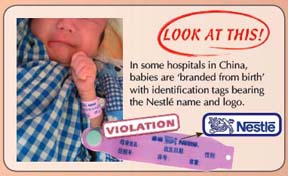 |
|
Issue
42: November 2009
Check out the following in our on-line Virtual Shop :
Table of ContentsNestlé boycott news
Editorial: Strong regulations needed as Nestlé and Danone battle it out in a consolidating marketNestlé
is the
target of a boycott because it is found to be the worst of the baby
food companies. Several stark examples from South Africa, Laos, and China (below)
are highlighted in this
issue. In South Africa Nestlé claims its formula ‘activates your baby’s immune system’ and promotes it in supermarkets. The Infant Feeding Association, the industry body, reported Nestlé’s supermarket campaign as a breach of the South African Advertising Code and the International Code of Marketing of Breastmilk Substitutes. (The strong law has not yet come in). When even its own competitors accuse it of breaking the rules, it really is time for Nestlé to drop the pretence that it complies. IBFAN’s monitoring round-up in 69 countries, Breaking the Rules, Stretching the Rules 2007, showed Nestlé again to be the leading violator of the Code.
Nestlé has since taken over Gerber, meaning the end of the commitment of previous owner, Novartis, to make it Code compliant. There are rumours that Nestlé is in the market to add Mead Johnson to its infant nutrition empire. The report, Breaking the Rules, shows the NUMICO companies (Nutricia, Milupa, Cow & Gate) getting worse, particularly as they battle Nestlé for market share in Asia. Danone has since bought NUMICO and is now No 1 in Europe and No 2 in the global baby food market. In response to IBFAN, Danone promised to carry out a ‘root and branch’ review of its marketing operations. Sadly its policy contains similar weaknesses to that of Nestlé, and with new aggressive campaigns launched, our initial hope of an improvement has been short lived. So the market is consolidating around two big players who seem to care little about their responsibilities, infant health or mothers’ rights. It all comes down to profits. All the more reason to push for strong regulatory systems and support Baby Milk Action’s work.
Protection
for breastfeeding in public in the UK
|
| Breastfeeding
picnics in front of Parliament and around the country on 21 July, with
the theme ‘Protect me, protect my baby’. Hostile
comments appeared on some media websites - see analysis at: one-of-those-women.blogspot.com /2008/08/lactaphobia.html |
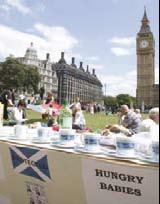 |
The Mother magazine launched another protest and petition on the Downing Street website (with 7,000 signatures so far). Sign at: petitions.number10.gov.uk/breastfedright/
|
 |
ECO Baby trick
In May we accepted an offer from a magazine called Eco Baby Guide (free with Healthy & Organic Living) for an advert for Baby Milk Action. We did this on the verbal understanding that the magazine would not be carrying adverts for breastmilk substitutes including follow-on milks.
Such advertising breaches the International Code of Marketing of Breastmilk Substitutes - companies are limited to providing factual and scientific information to health workers who are given responsibility for advising parents.
|
Much to our horror when the magazine came out we discovered the publishers do not respect the Code after all as our advert was placed right next to 2 adverts for Babynat and Hipp organic follow on formulas. ECO Baby has refused to print an apology. We wish to make it known we would not have run and advertisement in the magazine had we been correctly informed of its policy. |
Breastfeeding promotion
Going for Gold - World Breastfeeding Week 2008
This year’s theme for World Breastfeeding Week (WBW) was Going for Gold, tying in with the Olympics in China. WBW is organised by the World Alliance for Breastfeeding Action (WABA) and Baby Milk Action is a member.| This map, from the site www.waba.org.my, shows torches for events around the world, mainly held in August and October. Organisers could also apply for medals in a ‘marathon,’ awarded for events of long duration, such as over a week. | 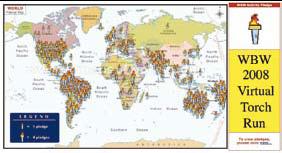 |
1,600 mothers breastfeeding in the Amazon Forest
IBFAN Brazil organised the biennial National Breastfeeding Conference in May in Bethlehem (Belém), Pará State, which makes up part of the Amazon rainforest.1,600 mothers turned out to breastfeed alongside the Guajará River, including a contingent involved with Brazil’s famous babyfriendly fire fighters, who held a parallel event within the conference.
Baby Milk Action’s Campaigns and Networking Coordinator, Mike Brady, was a guest international speaker on holding corporations accountable (see the report on his contribution to a new book on ending hunger).
- Last year over 10,000 mothers in 42 countries and 352 locations breastfed simultaneously. This initiative, coordinated by campaigners in the Philippines, has now been recognised by the Guinness Book of Records.
Reaching a new generation in the UK with Posters and DVDs
From Bump to Breastfeeding is a new DVD from Bestbeginnings available free from the Department of Health website (www.orderline.dh.gov.uk). Watch it on line at: http://www.bestbeginnings.info/video/Totally and utterly different from the Nestlé-sponsored Video for Teenagers which raises problems but fails to provide answers - the From Bump to Breastfeeding DVD will be a great help to new mothers.
| The poster, right, from beastar.org.uk and a radio advert in Lancashire promote breastfeeding and an information and chat website using local mums. |  |
Is breast best - or just normal?
Dr. Diane Wiessinger warned in the Journal of Human Lactation in 1996 (Vol. 12, No. 1) of the risks of promoting breastfeeding as providing advantages and being optimal. She said:
She explores at length why speaking this truth makes some mothers feel guilty.When we talk about the advantages of breastfeeding - the “lower rates” of cancer, the “reduced risk” of allergies, the “enhanced” bonding, the “stronger” immune system - we reinforce bottlefeeding yet again as the accepted, acceptable norm.... Our own experience tells us that optimal is not necessary. Normal is fine, and implied in this language is the absolute normalcy - and thus safety and adequacy - of artificial feeding. The truth is, breastfeeding is nothing more than normal. Artificial feeding, which is neither the same nor superior, is therefore deficient, incomplete, and inferior.”
Dr. Karleen Gribble made the same case at an Australian Breastfeeding Association conference, pointing out that in choosing her clothes for the event she didn’t go for the ‘best’ - a trip to Paris for the latest designs - but for something adequate. See: youtube.com/watch?v=M8BjnGCNahU
UK regulations are “inadequate... aggressive promotion of breastmilk substitutes remains common” - says UN report
In
September we warmly welcomed the badly needed £2million
Government grant to UNICEF UK’s Baby Friendly Initiative
(BFI), but our concerns remain about the lack of action on marketing
and the Government’s failure to listen to health
professionals and to its own advisory body (SACN). In September the UK
was called to answer questions from the UN Committee on the Rights of
the Child (CRC) - 5 years after being told by the Committe to implement
the Code.
We presented evidence to the CRC Committee, including the Baby Feeding Law Group (BFLG) monitoring
reports, which we produce and coordinate. The Committee was
unimpressed by the Government’s submission which claimed it
had implemented the International Code.
CRC Committee responds to UKThe Committee, while appreciating the progress made in recent years in the promotion and support of breastfeeding in the State party...is concerned that implementation of the International Code of Marketing of Breastmilk Substitutes continues to be inadequate and that aggressive promotion of breastmilk substitutes remains common.... The Committee recommends that the State party implement fully the International Code of Marketing of Breastmilk Substitutes. |
| The Government’s Sure Start centres have been active in promoting and supporting breastfeeding, particularly targeting disadvantaged areas where rates are often lower - the report right was part of the Government’s submission to the UN. | 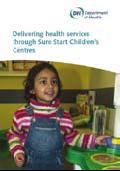 |
Sadly, when it comes to protecting breastfeeding, company profits seem to matter more than health.
All the leading health professional bodies and mother-support groups in the Baby Feeding Law Group and beyond supported stronger regulations during a consultation last year. Prof Mary Renfrew, Chair of the Breastfeeding Manifesto Coalition (BMC), wrote in her letter to Dawn Primarolo MP, Minister for Public Health:
Because this advice was not taken the new Infant Formula and Follow-on Formula Regulations (2007) are a travesty, with the few new safeguards undermined by the lack of controls on follow-on milk advertising and the new nutrition claims permitted by the new law.
In an attempt to appease the health lobby, the Minister promised to immediately implement the Regulations, alongside legally enforcable Guidance Notes, and to carry out a 12-month independent review on their impact. She also promised to strengthen the Regulations if it was found to be necessary following an Independent Review. We were told that the Guidance Notes would address many of our concerns. However, as we report below, in practice companies are ignoring them with little action taken. The final Regulations were introduced in February following a legal challenge from the industry to delay key provisions.
For the government's report see: everychildmatters.gov.uk
IDFA vs UK Government
Following the consultation on the Infant formula Regulatons, the UK Government took the industry line of minimum action. Doing little to strengthen marketing restrictions, it legitimised some of the claims companies had been using illegally for years.But the industry was not satisfied, hating the sections which protect health, such as the new requirement about storage and disposal of formula (because of the risk of intrinsic contamination) and the requirement to make a clear distinction in labelling and marketing between follow-on formula for older babies and infant formula for newborns.
The day before the Regulations were due to come into force the Infant and Dietetic Food Association (IDFA) called for a Judicial Review in England and Wales, Scotland and N. Ireland - arguing that they should be allowed two years to implement the labelling (and possibly the advertising) requirements. The Regulations were immediately suspended in England, Wales and N. Ireland but remained in force in Scotland.
We were not happy with the Regulations, but given the promise of an Independent Review during the first year, we decided that it was important to defend the Government’s right to bring in the Regulations straight away. We submitted evidence as an ‘Interested Party’ on behalf of both the Baby Feeding Law Group and the Breastfeeding Manifesto Coalition at the two-day High Court hearing in London. We also attended the Scottish case as an observer.
We took the view that as existing formula labels breached the Regulations dating from 1995 and should, by rights, be re-labelled, it made little sense to delay the new provisions. However, the court case did not consider such practicalities, instead arguing over the meaning of one word - “product” - in the legislation. Thanks to semantics, the industry won.
- In general the revised EU Directive has weakened the implementation of the Code in Europe, with Ireland and the Netherlands now permitting infant formula advertising when they once banned it. Italy planned to ban follow-on milk advertising, but this seems likely to change under the new regime. Luxemboug has, however, banned follow-on milk advertising.
BFLG reports track formula marketing strategies and action (or lack of it) by authorities
Baby Milk Action coordinates a UK monitoring project on behalf of the Baby Feeding Law Group (BFLG). Since May, we have been producing quarterly reports, which are accepted by Trading Standards Home Authorities responsible for each formula manufacturer and their umbrella body, LACORS. We also send them to the Government’s Independent Review Panel and to the Advertising Standards Authority (ASA). Many thanks to everyone who sent us evidence.The May 2008 report recorded some of the key concerns about practices by the different companies. The next report in August included responses from the Nestlé and Wyeth/SMA home authorities, the only ones who responded, and evidence of new promotional campaigns launched in the intervening three months.
Danone: from bad to worse
At the beginning of the year, we were in communication with Mr. Frank Riboud, CEO of Danone, following the company’s takeover of NUMICO, which owned the Nutricia, Milupa and Cow & Gate brands. Danone is now a major player in the EU and global baby food market. Ribaud promised a ‘root and branch’ review of marketing practices which we welcomed on our March 2008 Campaign for Ethical Marketing action sheet. But time has passed we are now seeing Danone’s strategy.
While pretending to the UN bodies that it is only interested in improving nutrition for young children, Danone is aggresively expanding its whole range of milks, including follow-on milks and growing-up milks* and doing so in ways that undermine breastfeeding.
| For example, this TV advert (rigth) for Aptamil formula, highlighted in the May report, suggests that the protective shield provided by breastfeeding is also provided by Aptamil formula. | 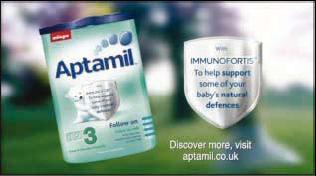 |
The ‘Immunofortis prebiotics’ claim is used despite being non-compliant with the Infant Formula and Follow-on Formula Regulations in both their 1995 and 2007 versions.
In July, Danone began advertising Cow & Gate formula on TV with an advert showing laughing babies (inspired by a popular Youtube clip). The advert also claims that it provides for ‘natural defences’ despite a previous ASA ruling against a similar Cow & Gate claim in print advertising. |
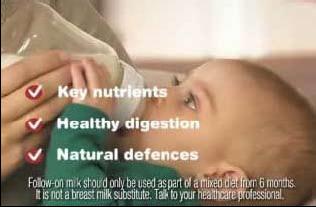 |
We reported this advert to the ASA also, but it has been cleared because even though it shows bottle feeding, the small print running along the bottom of the screen mentions follow-on formula, which is unregulated in the UK.
* Numico’s website reports that in 2007 sales of growing-up milks rose by 15.8% and prepared foods and follow-up milks rose by 12%.
Cow & Gate and Hipp launch Good Night milks
|
A major promotion has been launched for the new product Cow & Gate Good Night milk, backed by special displays and discounts, such as that shown in Boots, right, in April 2008. The product is a follow-on milk with added potato starch and rice flakes. |
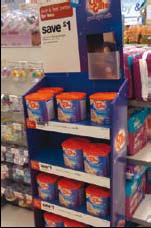 |
| The advert (right) in the celebrity magazine Reveal in March 2008 and on a 12-page booklet, encourage mothers to visit the Cow & Gate website where the full range of products is promoted. The promotion is dominated by the idealising text and image implying that it will help infants sleep, playing on a parent’s insecurities and concerns about night feeding. The name itself is an idealising claim which has no supporting evidence and has not been submitted to or passed by the European Food Safety Authority (see P 14). |  |
The advert states :
New Cow & Gate Good Night milk has been specially developed to help settle your baby at bedtime. Thicker than regular follow-on milk, but gentle on your baby’s tummy, it provides a warm, contented and satisfying end to the day.
This promotion undermines the Department of Health recommendation to continue breastfeeding beyond 6 months and long-standing health advice not to feed anything other than milk or water using a bottle.
Goodnight milks could lead to babies being overfed as parents try to keep them asleep. It’s also easier to consume calories as a liquid than as solid food and babies tend to consume any liquid in their mouths, regardless of hunger, because of their swallowing reflex.
The
Government’s Scientific Advisory Committee on Nutrition
(SACN) discussed
Goodnight Millks in
October.
Hipp also
has a brand of
Goodnight Milk Drink.
|
The advert (right) in Prima Baby magazine, Sept.08 suggests that thanks to the milk “...everyone can get a good night’s sleep... the ideal end to a busy adventure filled-day.” |
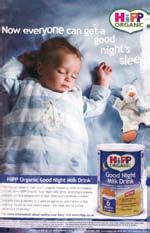 |
Heinz launches a new formula: prohibited claims, coordinated promotion and inflated prices
The
August 2008 report we produced for the BFLG monitoring project,
documented the launch of Heinz Nurture formula. Heinz provides a lesson
in how to promote formula - if you are not concerned with bending and
breaking the law.
Cross-promotional product range
The UK regulations currently allow follow-on formula to be promoted to the public, but not infant formula. The law also states that these should be packaged differently but, following the Judicial Review (see above) the companies do not have to comply with this until 2010.
They have, however, been asked to comply immediately with the Guidance Notes which describe how the law should be interpreted. The new Heinz range ignores this and uses similar branding to make the products cross-promotional.
Idealising claims
| The infant formula label has a logo, ‘science behind nurture’ and the claim, ‘Prebiotics,’ which is not on the permitted list. | 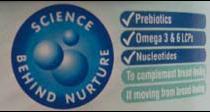 |
Heinz was reminded of this by the Food Standards Agency in 2006. The next quarterly report will indicate whether action is taken on this illegal claim which misleadingly suggests that the formula provides health benefits. Artificially fed infants are more likely than breastfed infants to suffer short and long-term illness. Breastmilk contains over 130 oligosaccharides which act as prebiotics. Foods such as bananas also have a prebiotic effect.
Pushing formula through the follow-on formula loophole

Having created a cross-promotional range, Heinz then uses another loophole to promote the third tin shown above on television and in print with the idealising claims “New Nurture helps nourish, protect and develop your baby.”
The advertised website promotes the full range of formulas. Though the formula in the advertisment is called Nurture, Heinz seems to belief the fact the tin shown is orange will prevent any action being taken against it.
| Promotion
in
supermarkets, ostensibly for the follow-on milk (the orange tin), is
placed with the infant formula - something explicitly prohibited by the
Guidance Notes. The example shown here is from Boots in August. |
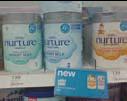 |
Co-opting health workers to justify higher prices
Nurture was promoted to health workers with the disease risk reduction claim: “a new arrival offering constipation relief” (a claim not on the approved list). The old Farley’s brand wasbpromoted to health workers as the “Best formula. Best value... Committed to fair prices.” Nurture is about £3 a tin more expensive than Farley’s.
Lack of enforcement leads to an increase in promotion by Wyeth/SMA
The
Trading Standards Home Authority for Wyeth/SMA was one of two that
responded to the May 2008 monitoring report.
Guidance Notes
unenforceable?
The Guidance Notes which accompany the Regulations clarify the Law and
are intended to have the same force. So far industry is ignoring them.
During the consultation, they said:
The Government took a different view and these provisions remained in
the Guidance Notes, which we were assured would be enforced. However,
Trading Standards said of promotion breaching these provisions:
It may not comply with good
practice in the Guidance Notes, but it does not infringe the 2007
Regulations. Therefore enforcement action cannot be taken.
Trading Standards is also not taking action on labels
| For
example, the
stylised breastfeeding mother, introduced after Wyeth was forced to
remove its ‘now even closer to breastmilk’ slogan. The Home Authority stated: “It is too subjective. I have done several straw polls and some people simply see an M and not a breast feeding mother.” |
 |
Our straw polls found the opposite. We ask the question, why not just use a letter M? Why have the two red dots?
Promotion increases
Brand Republic reported in May : “SMA Nutrition, the baby milk formula brand, is on the hunt for an agency to handle its direct marketing account.”
This increased direct promotion to mothers is in addition to an existing £3 million advertising campaign.
Warning on Nestlé Teenage video
Nestlé is trying to enter into the UK mass formula market and is working closely with midwife Chris Sidgwick who launched a Nestlé video at a past Royal College of Midwives conference and suggested in the British Journal of Midwifery that healthworkers should look to Nestlé for sponsored materials.At the time we raised the point that such resources can only be distributed with the prior approval of the Department of Health, which has not been given. Trading Standards agreed but has taken no action apart from asking Nestlé to try to obtain approval yet again.
The BFLG, WHA and NICE position (see below) is that industry should not fund such materials.
2008 NICE Guidance gets tough on industry funded materials
The
National Institute for Health and Clinical Excellence
(NICE) published Guidance No 11 in March: Improving the nutrition of
pregnant and
breastfeeding mothers and children in low-income households.
Available at:
http://www.nice.org.uk/Guidance/PH11/
Recommendation 14 states:
Avoid promoting or advertising infant or follow-on formula. Do not display, distribute or use product samples, leaflets, posters, charts, educational or other materials and equipment produced or donated by infant formula, bottle and teat manufacturers.
Calendar and book offer
IBFAN’s 2009
breastfeeding calendar, with 12 A4-size full
colour pictures of breastfeeding mothers from around the
world, is now available. A great alternative to
corporate calendars. (£7 inc.UK p&p, £6
each orders of
10 or more).
Fit to Bust,
a book produced by Alison
Blenkinsop, features songs and text in
support of breastfeeding and the
Nestlé boycott (£11 inc. UK p&p). Alison is
donating money raised by the book to Baby Milk Action.
Order both items and we’ll send you a free set of humorous breastfeeding postcards, while stocks last.



